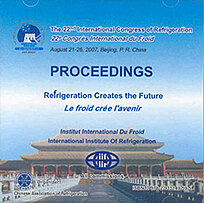
Document IIF
Evaluation de l'effet cryoproptecteur de sucres sur la survie d'erythrocytes humains cryoconservés à -80 °C.
Evaluation of the cryoprotective effect of sugars on survival of human erythrocytes cryopreserved at -80°C.
Auteurs : QUAN G. B., HAN Y., LIU M. X., et al.
Résumé
Sugars can be loaded into erythrocyte cytoplasma by simple incubation, which makes cryopreservation of human erythrocytes without glycerol feasible. The cryoprotective effect of sugars on human erythrocytes was evaluated in this study. Erythrocytes loaded with sugars were frozen in a formulation of polyvinylpyrrolidone, human serum albumin, and corresponding sugars. The data showed the efficiency of sugar loading was dependent on extracellular sugar concentration, incubation temperature and time. Sugars can decrease hemolysis and protect metabolic function of cryopreserved erythrocytes, especially for glucose. However, compared with glucose, trehalose can maintain phosphatidylserine distribution of cryopreserved erythrocytes. Finally, sugars can protect integrity of membrane morphology after freezing, but some cell shape appeared spherocytic or echinocytic. In conclusion, sugar loading benefits the survival of cryopreserved erythrocytes. But trehalose loading causes more cell injuries compared with glucose, and these injuries in turn manifest themselves during subsequent freezing and thawing.
Documents disponibles
Format PDF
Pages : ICR07-C1-1365
Disponible
Prix public
20 €
Prix membre*
Gratuit
* meilleur tarif applicable selon le type d'adhésion (voir le détail des avantages des adhésions individuelles et collectives)
Détails
- Titre original : Evaluation of the cryoprotective effect of sugars on survival of human erythrocytes cryopreserved at -80°C.
- Identifiant de la fiche : 2008-0938
- Langues : Anglais
- Source : ICR 2007. Refrigeration Creates the Future. Proceedings of the 22nd IIR International Congress of Refrigeration.
- Date d'édition : 21/08/2007
Liens
Voir d'autres communications du même compte rendu (839)
Voir le compte rendu de la conférence
Indexation
- Thèmes : Influence du froid sur les cellules, tissus et organes
- Mots-clés : Erythrocyte; Cryoprotecteur; Sucre; Homme; Experimentation; Cryoconservation; Congélation; Additif
-
THE MECHANISM OF STRUCTURAL AND OSMOTIC ADAPTAT...
- Auteurs : BABIYCHUK L. A., ZEMLYANSKIKH N. G.
- Date : 06/07/1989
- Langues : Anglais
Voir la fiche
-
Kryokonservierung von Blutzellen des Menschen.
- Auteurs : GEBAUER W., GEBAUER E. F., SCHUNTER F.
- Date : 17/11/1999
- Langues : Allemand
- Source : DKV-Tagungsbericht 26. 1999, Berlin.
Voir la fiche
-
KINETIC APPROACHES TO CRYOPRESERVATION OF RED C...
- Auteurs : ROWE A. W.
- Date : 06/07/1989
- Langues : Anglais
Voir la fiche
-
OPTIMAL CONCENTRATION OF CRYOPROTECTANT AND THE...
- Auteurs : SUMIDA S., MATSUKI R.
- Date : 11/10/1989
- Langues : Anglais
Voir la fiche
-
STORAGE OF ERYTHROCYTES AT 253 TO 249 K (-20 TO...
- Auteurs : DAZYNSKI J.
- Date : 01/06/1981
- Langues : Anglais
- Source : Cryosurgery and medical applications of refrigeration: current situation and perspectives.
- Formats : PDF
Voir la fiche
